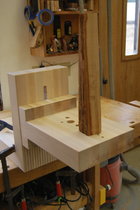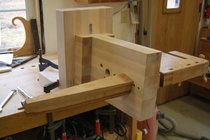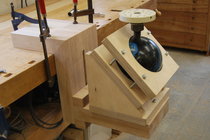As my feet continue to go to hell I suspect more of my woodworking may be tethered to a chair in the future. What carving and shaping I have done has been at benchtop height or above. I have had a Veritas carver's vise https://www.leevalley.com/en-us/shop...s&item=05G2001 for some time and it is a well made, versatile piece of kit but it has limited height adjustment and is not really stout enough for heavy mallet blows.
Looking around for height-adjustable heavy duty stand designs I found the European floor-mounted units used at the Geisler-Moroder school https://www.schnitzeisen.at/werkstat...d-schnitztisch but decided against taking up more floor space in my small shop. Chris Pye has a nice bench-mounted design in his book Elements of Woodcarving but its base design puts the work too high for a seated carver. Finally I came across the Pfeil stand which could be turned upside down for a wider range of working heights and decided to make a version of it https://www.pfeiltools.com/katalog/#page-60 with a hefty rotating ball vise.
For the adjustable height stand I cut up some 8/4 flatsawn hard maple into 3"+ rift and quartered slices and laminated them into a plank big enough for the slotted stand and shelf.

 I miterfolded the right angle section, then slotted it with a 12" sawblade for 1/8" splines 1/2" on center. Rather than rout the height adjustment slot 3" deep I dry-clamped two halves of the upright, bored end holes and bandsawed the slot before the final glueup. I countersunk the slot so the nut would not make the upright stand off from my bench apron. The shelf is secured to the stand with a length of 5/8" threaded rod bored into the end grain and both epoxied and nutted in a cross-hole bored in the face.
I miterfolded the right angle section, then slotted it with a 12" sawblade for 1/8" splines 1/2" on center. Rather than rout the height adjustment slot 3" deep I dry-clamped two halves of the upright, bored end holes and bandsawed the slot before the final glueup. I countersunk the slot so the nut would not make the upright stand off from my bench apron. The shelf is secured to the stand with a length of 5/8" threaded rod bored into the end grain and both epoxied and nutted in a cross-hole bored in the face.
For the ball vise I made a stand of 1.4" thick laminated baltic birch plywood with lathe-turned clamping plates. The bowling ball was fitted with a piece of 1 1/4"-8 threaded rod and nut from McMaster Carr to accept standard faceplates. The rod is embedded 4" deep and epoxied into the ball.
The whole affair may be a bit overdone, but it is bomber and leverages the stability of my existing bench to make a versatile carving station that will hold up to heavy work. It is made for general carving but I thought that some of the turners here might find it useful, particularly the ball vise.
Looking around for height-adjustable heavy duty stand designs I found the European floor-mounted units used at the Geisler-Moroder school https://www.schnitzeisen.at/werkstat...d-schnitztisch but decided against taking up more floor space in my small shop. Chris Pye has a nice bench-mounted design in his book Elements of Woodcarving but its base design puts the work too high for a seated carver. Finally I came across the Pfeil stand which could be turned upside down for a wider range of working heights and decided to make a version of it https://www.pfeiltools.com/katalog/#page-60 with a hefty rotating ball vise.
For the adjustable height stand I cut up some 8/4 flatsawn hard maple into 3"+ rift and quartered slices and laminated them into a plank big enough for the slotted stand and shelf.


 I miterfolded the right angle section, then slotted it with a 12" sawblade for 1/8" splines 1/2" on center. Rather than rout the height adjustment slot 3" deep I dry-clamped two halves of the upright, bored end holes and bandsawed the slot before the final glueup. I countersunk the slot so the nut would not make the upright stand off from my bench apron. The shelf is secured to the stand with a length of 5/8" threaded rod bored into the end grain and both epoxied and nutted in a cross-hole bored in the face.
I miterfolded the right angle section, then slotted it with a 12" sawblade for 1/8" splines 1/2" on center. Rather than rout the height adjustment slot 3" deep I dry-clamped two halves of the upright, bored end holes and bandsawed the slot before the final glueup. I countersunk the slot so the nut would not make the upright stand off from my bench apron. The shelf is secured to the stand with a length of 5/8" threaded rod bored into the end grain and both epoxied and nutted in a cross-hole bored in the face.For the ball vise I made a stand of 1.4" thick laminated baltic birch plywood with lathe-turned clamping plates. The bowling ball was fitted with a piece of 1 1/4"-8 threaded rod and nut from McMaster Carr to accept standard faceplates. The rod is embedded 4" deep and epoxied into the ball.
The whole affair may be a bit overdone, but it is bomber and leverages the stability of my existing bench to make a versatile carving station that will hold up to heavy work. It is made for general carving but I thought that some of the turners here might find it useful, particularly the ball vise.
Last edited:
